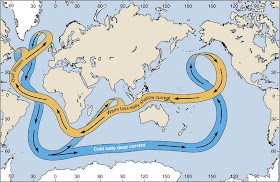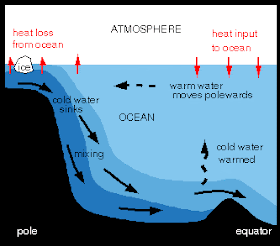Definitions:
- El Nino - warm surface waters prevail periodically in the eastern equatorial Pacific. South American fishermen named the phenomena, it is Spanish for ‘The Christ Child’ because it peaks at Christmas.
- La Nina – colder than average sea surface temperatures in the central and eastern equatorial Pacific. This is described as an exaggerated, more extreme episode of the normal year.
- Southern Oscillation – atmospheric pressure fluctuations between Pacific and the Australasia area.
- ENSO – (El Nino Southern Oscillation) is the term used to encapsulate all of the associated natural events.
Normal Conditions:
1. Trade winds flow equatorwards and westwards across the Tropical Pacific.
2. The winds blow in towards the warm water of the western Pacific.
3. As the warm water is heats the atmosphere, convectional uplift of air masses occurs.
4. Upwelling of cool water can take place along the east coast of Peru because of the shallow position of the thermocline and the strength of the westerly trade winds.
5. The cool water is nutrient rich, boosting the aquatic ecosystem and thus the fishing industry.
6. The pressure of the trade winds forces sea levels in Australasia to rise by 50 cm above those off the Peruvian coast and the surface sea temperatures are 8 °c higher.
7. The air over Australasia subsides – known as the Walker Loop.
Sequence of events in an El Nino cycle:
- The trade winds in the western Pacific weaken or reverse and flow from eastwards.
- This allows warm water currents to flow from the west to the east.
- Sea levels level out and surface waters off the south American coast warm, limiting the upwelling of cold deep water.
- The eastern Pacific Ocean becomes 6 – 8 °C warmer.
- The formation of clouds and tropical storms increases as the surface of the ocean warms. However, rather than being confined to the tropical islands of the western Pacific, they migrate eastwards, affecting usually arid environments like the deserts of Peru.
- Conditions are generally calmer throughout the Pacific.
Sequence of events in an La Nina cycle:
- Extremely strong trade winds.
- Trade winds force warm water westwards, pushing sea level up to 1 m in Indonisia and the Philippines higher than the sea level in the east.
- Low-pressure systems form with significantly stronger convectional uplift as the warm air heats the atmosphere. Torrential rainfall is frequent in southeast Asia.
- Enhanced up-welling of cold water off the coast of Peru leads to strong high pressure and extreme drought.
The cycle reverses every 1 to 5 years.
Recommended Resources:
A good website for pupils to explore for research based homework:
Check out what is happening today by analysing the animation from the NOAA. The simulation could be shown to challenge pupils to work out for themselves current stage of the ENSO cycle.






























